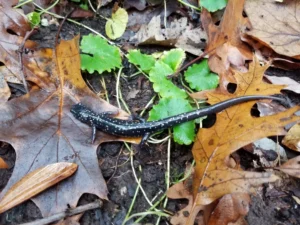Salamanders are fascinating and delicate amphibians that have been around for millions of years. They have survived for so long because they are adaptable, but even so, many things today can harm or kill them. So, what actually kills salamanders today?
Salamanders can be harmed or killed by habitat destruction, pollution, diseases, predators, climate change, and even poor care in captivity. Their skin is very sensitive, and they need moist, safe environments. Because of this, small changes in their surroundings can be very dangerous.
Habitat Destruction Is a Leading Cause of Salamander Deaths
One of the biggest threats to salamanders is the loss of their homes. Salamanders need moist, shaded places such as forests, wetlands, and clean streams or ponds to hide, feed, and lay eggs.

Human activities like logging, farming, building towns, and mining can damage or remove these homes. When forests are cut down or wetlands drained, salamanders lose the shelter and breeding areas they rely on.
Even partial damage to their homes can separate populations, making it harder for salamanders to find mates and lowering the diversity of their genes. Habitat destruction also exposes them to hotter, drier conditions they cannot handle.
Protecting forests, wetlands, and clean waterways is very important to keep salamander populations healthy.
Pollution Severely Harms Salamanders
Pollution is another serious threat. Salamanders breathe partly through their skin, so they absorb chemicals from their environment very easily.
Common pollutants that hurt salamanders include:
- Pesticides and herbicides from farms
- Heavy metals and waste from factories
- Runoff from fertilizers that causes algae to grow
- Acid rain that changes the water in ponds and streams
Even small amounts of these chemicals can weaken a salamander’s immune system, making it easier for them to get sick and harder to reproduce.
Pollution can also hurt salamanders indirectly by reducing the insects and small animals they eat.
Because salamander populations are often small and isolated, local pollution can wipe them out quickly.
Diseases Pose a Growing Threat to Salamanders
Diseases are another major cause of salamander deaths. One of the most dangerous is chytrid fungus, which causes chytridiomycosis. This is a disease that infects amphibian skin and messes up their breathing and water balance.

Ranavirus is another harmful disease. It causes skin sores, internal bleeding, and death in infected salamanders.
These diseases can spread quickly, especially when salamanders are stressed, crowded, or living in polluted environments.
Research and careful monitoring are very important to understand these diseases and find ways to reduce their impact.
Predators Kill Salamanders, Especially Young Ones
Salamanders are food for many animals at all stages of life. Adults often have protection like camouflage or toxic skin secretions, but babies and larvae are very vulnerable.
Predators include:
- Birds such as herons and owls
- Snakes and bigger amphibians
- Fish that eat larvae in ponds and streams
- Mammals like raccoons, skunks, and foxes
- Aquatic insects and crustaceans
Predation is normal in nature, but when homes are damaged or hiding spots are limited, more salamanders can get eaten. Keeping habitats healthy with plenty of cover helps young salamanders survive.
Climate Change Threatens Salamanders’ Survival
Climate change is becoming a big problem for salamanders. Changes in temperature and rainfall affect the moist places they rely on.
Warmer temperatures and drier conditions can cause dehydration and stress. Changes in seasonal rainfall can mess up breeding cycles and reduce the number of eggs that survive.

Extreme events like floods or droughts can destroy eggs, larvae, or adult homes. Climate change may also increase disease and change predator-prey relationships.
Restoring habitats and keeping them connected can help salamanders cope with these changes.
Improper Care in Captivity Can Lead to Salamander Deaths
Many people keep salamanders as pets, but taking care of them properly is very important.
Common mistakes include:
- Wrong temperature or humidity
- Using untreated tap water with chemicals like chlorine
- Feeding diets that lack important nutrients
- Overhandling or stressing the animal
- Using toxic bedding or cleaning products in the enclosure
Salamanders have delicate skin that absorbs harmful substances easily. Doing any of these things can make them sick. Learning the specific needs of each species and keeping their habitat clean and stable is very important for captive salamanders.
Additional Factors That Can Kill Salamanders
Other risks also affect salamanders:
- Roadkill: Many salamanders cross roads to reach breeding sites.
- Invasive Species: Non-native fish or amphibians can compete for food or eat salamanders.
- Increased UV Radiation: Less ozone means more sunlight can harm eggs and larvae.
- Chemical Exposure: Household chemicals that reach water can poison salamanders or their food.
Knowing about these risks and taking steps to reduce them can help salamanders survive longer.
Conclusion
Salamanders face many threats, including habitat destruction, pollution, disease, predators, climate change, and poor captive care. Their sensitive skin and specific environmental needs make them vulnerable, but learning about these risks is the first step in protecting them.
Protecting and restoring habitats, reducing pollution, monitoring diseases, and giving proper care in captivity are all very important to make sure salamanders continue to thrive.
Hi, my name is Ezra Mushala, i have been interested animals all my life. I am the main author and editor here at snakeinformer.com.

